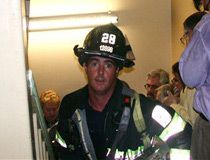By FireRescue1 News Editor
Fire-resistant high-rise elevators have been an issue of discussion – but little else – for decades in the U.S.
While some fire departments allow crews to use existing standard elevators during incidents, others deem it too risky.
But, in a matter of weeks, new codes are likely to be approved that could finally make fire-resistant high rise elevators – complete with robust electrical components and air pressure systems – a reality across the country.
In May, representatives of the International Code Council (ICC), which is dedicated to building safety and fire prevention, will meet in New York to vote upon new proposed code changes.
Among them is a standard governing designated elevators for the fire service, which sets a recommendation that new buildings 120 feet or higher have a minimum of one dedicated lift for use by firefighters in emergencies.
If it comes into effect, as industry experts predict, it would allow the U.S. to become a world leader in the field.
When it comes to fire-resistant high-rise elevators for firefighters, the U.S. has long lagged behind other countries.
Stricter codes
Since the mid-1980s, the U.K. has had similar legislation in place governing the need for firefighter lifts in tall buildings. The rest of Europe and many Asian countries soon followed suit.
But unlike standards in those countries, where the dedicated fire-service lifts rest idle in non-emergency periods, the code being proposed in the U.S. would allow for regular use of the elevator during normal hours, too.
Richard Bukowski, the standards and codes coordinator for the Building and Fire Research Laboratory of the National Institute of Standards and Technology (NIST), said the rest of the world would likely follow the lead of the U.S. if the code passes.
The NIST, along with the American Society of Mechanical Engineers (ASME), has played a leading role in drawing up the proposed new code.
“The Office of the Deputy Prime Minister in the U.K, which governs fire safety, is very interested in what we are doing, and so are organizations in other countries,” Bukowski said.
“Once we have got the specification out and complete, I think more and more people will follow what we are doing.”
Despite being talked about since the 1970s, the push for fire-service elevators only gained momentum after 9/11.
“Post-9/11, it became clear that in very tall buildings you can’t have firefighters running up 50 flights of stairs and then expect them to do anything once they have got there,” Bukowski said.
“It’s also unreasonable to expect large numbers of people to have to go down several dozen flights of stairs and get out safely.”
 AP PHOTO/JOHN LABRIOLA Firefighter Mike Kehoe evacuates people during the 9/11 attacks on the World Trade Center. The tragedy has prompted several building-safety initiatives. |
Faster evacuations
Occupant egress elevators, which would facilitate much faster evacuation of tall buildings, are the subject of a second code that the NIST and the ASME have been working on. It is likely to go before the ICC for approval in 2012.
For both codes, it would be up to local governments to adopt or modify them.
Bukowski said he was confident that would happen, despite a common argument that building codes are usually designed with costs and manpower in mind, not the safety of firefighters.
“This is an argument that I have heard before,” Bukowski said, “but I think times are changing, especially post-9/11.
“US building codes have in the past not included safety of first responders as an explicit objective as is done in many other countries.
“After the losses on 9/11, this has been the subject of some debate. The thinking today is that the codes need to consider the safety of the first responder in cases where they do not have the option to pull back and mount an exterior attack.”
NFPA involvement
The National Fire Protection Association (NFPA) has also been working with the NIST and the ASME on adopting both the codes.
NFPA committees have already looked at the proposals, which could be adopted in 2009’s revised NFPA 101 Life Safety Code and NFPA 5000 Building Construction and Safety Code, respectively.
“In my view, it will be incumbent on the governing body of the city to move new buildings into this newer technology,” said Robert Solomon, assistant vice president for building and life safety codes at the NFPA.
 Richard Bukowski is confident the new code will be adopted |
“The reality is, the better the elevator equipment, the less time it will take to move occupants out of a high rise should a full building evacuation become necessary. Conversely, this same equipment will facilitate safe ingress to the fire floor by the fire department.
He added the new codes would help to clear up existing confusion among fire departments on whether to use high-rise elevators in emergencies.
“There are some fire departments that, once assured the elevators have not been subjected to damage or harm, do use elevators right now,” he said.
“But what the new legislation will do is make all fire departments confident about using them because of more robust electrical equipment components in the elevators.”
SF leads the way
Last month, it was reported that San Francisco could be at the forefront of the fire code changes because of recent proposals to construct some of the nation’s tallest residential towers in the city.
But Solomon said he hoped the San Francisco would not move too quickly.
“It (San Francisco) is unlikely to go too far until a nationally recognized standard relating to electrical equipment in elevators itself comes out, because if it isn’t done right, it would sour things for all the other jurisdictions,” said Solomon.
He admitted the proposed codes were a long time coming.
“What is interesting is that you can find government reports dating back to 1972 that talk about these same concepts,” he said. “They talk about the need to find out how elevators can be utilized during a fire event.
“This is something that has been looked at in the past by the NFPA, but it’s never really got anywhere.
“But now we really have a clear momentum going and are moving forward.”
Discuss this story in the Columns and Exclusives section of FireRescue1 Forums
| Editor’s Note: For more information on firefighter elevators read, “S.F. urges new codes for fire-resistant high rise elevators,” on FireRescue1. |

